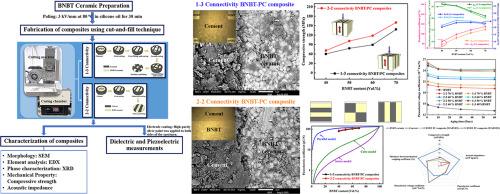用于结构健康监测应用的1-3和2-2连接无铅BNBT压电陶瓷/波特兰水泥复合材料的抗压强度、声学和老化压电性能
IF 5.7
3区 材料科学
Q2 MATERIALS SCIENCE, MULTIDISCIPLINARY
引用次数: 0
摘要
设计和制造了无铅0.94Bi0.5Na0.5TiO3-0.06BaTiO3 (BNBT)陶瓷/硅酸盐水泥复合材料,用于结构健康监测应用中的传感器。本研究探讨了BNBT含量和复合材料连通性对复合材料抗压强度、声学和老化压电性能的影响,旨在优化复合材料的性能。采用切割填充技术制备了含40 ~ 70 vol% BNBT的复合材料。d33和g33的最高测量值分别为115 pC/N和26.07 × 10 Vm/N。结果表明,增加BNBT含量和采用2-2连通性可提高复合材料的抗压强度,2-2复合材料的抗压强度优于1-3复合材料。所有复合材料的抗压强度均高于混凝土。掺入~ 40 vol% BNBT的复合材料与混凝土具有良好的相容性。在1 ~ 60 d的时效过程中,复合材料的g33值仍然高于单独的BNBT陶瓷,这表明复合材料设计具有明显的优势。本文章由计算机程序翻译,如有差异,请以英文原文为准。

Compressive strength, acoustic and aging piezoelectric properties of 1–3 and 2–2 connectivity lead-free BNBT piezoelectric ceramic/Portland cement composites for structural health monitoring applications
1–3 and 2–2 connectivity lead-free 0.94Bi0.5Na0.5TiO3–0.06BaTiO3 (BNBT) ceramic/Portland cement composites were designed and fabricated for use as sensors in structural health monitoring applications. This study investigates the effects of BNBT content and composite connectivity on compressive strength, acoustic, and aging piezoelectric properties, with the aim of optimizing composite performance. Composites containing 40–70 vol% BNBT were prepared using cut-and-fill technique. The highest measured values of d33 and g33 were 115 pC/N and 26.07 × 10⁻3 Vm/N, respectively. The results demonstrate that increasing BNBT content and employing 2–2 connectivity enhance the compressive strength of the composites, with 2–2 composites showing superior performance compared to 1–3 composites. All composites exhibited higher compressive strength than concrete. The composite with ∼40 vol% BNBT showed good compatibility with concrete. Between 1 to 60 days of aging, the g33 values of composites remained higher than those of standalone BNBT ceramic, highlighting a notable advantage of composite design.
求助全文
通过发布文献求助,成功后即可免费获取论文全文。
去求助
来源期刊

Materials Research Bulletin
工程技术-材料科学:综合
CiteScore
9.80
自引率
5.60%
发文量
372
审稿时长
42 days
期刊介绍:
Materials Research Bulletin is an international journal reporting high-impact research on processing-structure-property relationships in functional materials and nanomaterials with interesting electronic, magnetic, optical, thermal, mechanical or catalytic properties. Papers purely on thermodynamics or theoretical calculations (e.g., density functional theory) do not fall within the scope of the journal unless they also demonstrate a clear link to physical properties. Topics covered include functional materials (e.g., dielectrics, pyroelectrics, piezoelectrics, ferroelectrics, relaxors, thermoelectrics, etc.); electrochemistry and solid-state ionics (e.g., photovoltaics, batteries, sensors, and fuel cells); nanomaterials, graphene, and nanocomposites; luminescence and photocatalysis; crystal-structure and defect-structure analysis; novel electronics; non-crystalline solids; flexible electronics; protein-material interactions; and polymeric ion-exchange membranes.
 求助内容:
求助内容: 应助结果提醒方式:
应助结果提醒方式:


